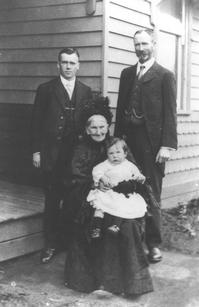


Weather News
Introduction
History
Fifty Years of Weather History
Weather Officers—25 Years Ago
The Perth RO Since 1929
Remember the Pioneers
Akeroyd the Great
Out with the Old—In with the New [Bill Gibbs / John Zillman]
Dr Bill Gibbs
Dr John Zillman
Meteorological History in the Territory
Edwin Thomas Quayle—Bureau Research Pioneer
Ninety Years Ago: Birth of the Bureau
Personal Notes
Retirements
Obituaries
Observers and Volunteers
Media
Computers
Index
Search
Help
Contact us

Edwin Thomas Quayle—Bureau Research Pioneer
No. 315 April 1997Weather News of August 1996 reported the discovery of a collection of 19th Century synoptic maps under a house in Melbourne's northern suburbs. Readers were invited to contact the Editor with any information. Don Linforth, retired STPM in Services Policy Branch, responded with the following tale of E. T. Quayle, the map collector.
E. T. Quayle was born in 1862 at Amphitheatre, near Avoca in Victoria.
After graduating in Arts he taught at Horsham, then Joined the staff of the Melbourne Observatory in 1890. He became Observer and Computer, assisting generally with Observatory work. He transferred to the Commonwealth Bureau when it began operations In 1908. As a Fourth Assistant on a salary of £310, he was being paid £10 more than at the Observatory.
In 1910 he bought a property on the Loddon river, which focussed his interest on seasonal forecasts and the growth of wheat. As a result he authored Bulletin No. 5: On the possibility of forecasting the approximate winter rainfall in northern Victoria.
In 1913 he was co-author, along with H. A. Hunt and Griffith Taylor, of the first text-book on Australian meteorology—Climate and Weather of Australia.
He developed a great interest in the movement of cirrus cloud as an indication of the high altitude winds, this being before the advent of pilot balloon flights. He wrote, in the Monthly Weather Report of December 1910, on the annual and seasonal variation in the direction of motion of cirrus clouds over Melbourne. This was elaborated upon in Bulletin No 10: The relation between cirrus direction as observed in Melbourne and the approach of various storm systems affecting Victoria, published in 1915. This interest continued throughout his life and his grand-daughter, Doris Graham, remembers him standing in his back garden in Essendon, arm extended to the sky, fingers splayed, to time the movement of clouds across the arc of sky. From this method he was able to estimate the wind speed at cloud level. His Bulletin No 15 (1917) analysed tropical control of Australian rainfall in the temperate belt.
In 1920 he became a member of the Royal Society of Victoria, reading several papers to Society meetings. These papers, subsequently published in Society proceedings, were on the modification of climate by human agency, primarily the effects of deforestation. In 1929 he wrote about long-range rainfall forecasting using Darwin air pressures. He developed an interest in the relation between sunspots and rainfall, reading a paper on the subject to the Royal Society in 1925. Bulletin No 22 on this topic followed some years later in 1938.

People in Bright Sparcs - Hunt, Henry Ambrose ; Linforth, Don; Quayle, Edwin Thomas; Taylor, Thomas Griffith
 |
Bureau of Meteorology |  |
© Online Edition Australian Science and Technology Heritage Centre and Bureau of Meteorology 2001
Published by Australian Science and Technology Heritage Centre, using the Web Academic Resource Publisher
http://www.austehc.unimelb.edu.au/fam/1316.html